Chefchaouen is a small city in northwest Morocco, sitting at 564 meters above sea level in the Rif Mountains. Founded in 1471, this city of about 42,000 people has become one of Morocco’s top tourist spots. Known for its blue-painted buildings, Chefchaouen covers about 10 square kilometers and enjoys a Mediterranean climate with mild, wet winters and warm, dry summers.
Unlike busy cities like Marrakech or Casablanca, Chefchaouen offers a slower pace. The city’s old town (medina) features narrow, winding streets lined with blue-washed houses, small squares, and local craft shops. Tourism has grown here since the 1980s, with visitor numbers reaching over 100,000 annually in recent years.
Culturally, Chefchaouen blends Moroccan and Andalusian influences, seen in its architecture, food, and traditions. Many locals speak Spanish alongside Arabic, reflecting historic ties with Spain. The city is known for its handwoven blankets, wool garments, and goat cheese, all part of the region’s Berber heritage.
For travelers, Chefchaouen provides a peaceful break from Morocco’s busier destinations. Its special blue color, mountain setting, and friendly atmosphere make it perfect for photography, hiking, and experiencing authentic Moroccan mountain life.
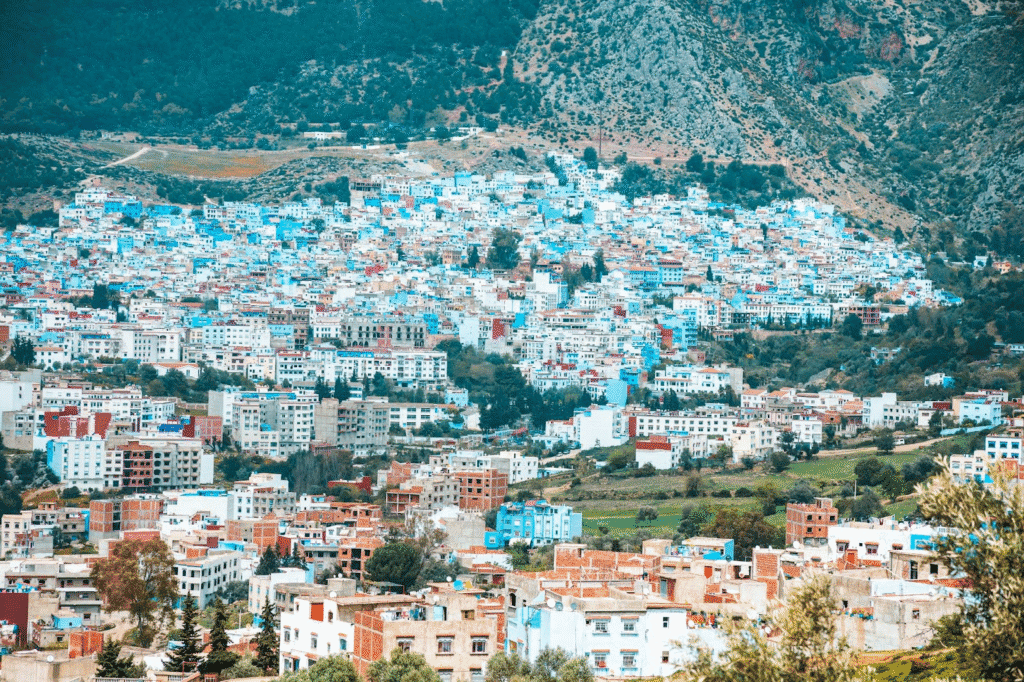
The Story Behind the Blue
Why is Chefchaouen blue? This question fascinates visitors who walk its painted streets. The answer isn’t simple – several stories explain this unique feature.
The most common explanation links the blue color to Jewish refugees. In the 1930s, many Jews escaped Europe and settled in Chefchaouen. They painted buildings blue because in Jewish tradition, blue represents the sky and heaven. The color reminded them of God’s power.
Some locals share more practical reasons. Many believe the blue paint works as a natural mosquito repellent. The cool color also might keep houses cooler during hot summer months – a smart trick in a mountain town without air conditioning.
Others say the blue helps with navigation. In a town of twisting alleys, having color-coded sections helps people find their way around. Before phones and maps, the blue served as a community GPS system.
Water plays a big role in Chefchaouen’s history too. The town’s name means “look at the horns” in the local Berber language, referring to the mountain peaks above that collect water. Some say the blue honors this precious resource in a sometimes dry region.
Today, the tradition continues partly because it draws tourists. The town refreshes the paint regularly, with families taking pride in maintaining their blue homes. What started as cultural or practical has become Chefchaouen’s identity – a tradition that connects past and present.
The blue isn’t just one shade either. Walking through town, you’ll notice blues ranging from sky blue to deep indigo, creating a living artwork that changes with the sunlight throughout the day.
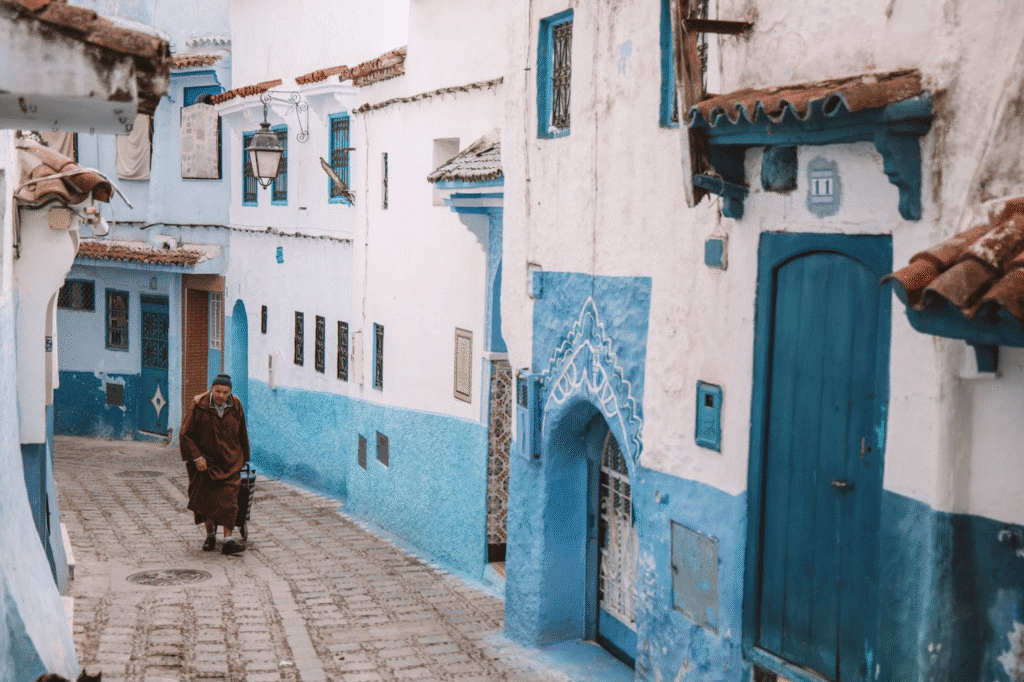
Getting to Chefchaouen
Chefchaouen sits in northern Morocco, about 110 km from Tangier and 200 km from Fez. Unlike big Moroccan cities, it doesn’t have its own airport or train station, making it a bit of an adventure to reach.
From Tangier, the fastest way is by car or taxi, taking about 2-2.5 hours on mountain roads. Public buses run daily for budget travelers, with CTM and Supratours offering reliable service for around 70-90 MAD (7-9 USD).
If coming from Fez, the trip is about 3.5-4 hours by car or taxi. Bus services run several times daily (100-120 MAD), but the winding roads make this a longer journey. From Casablanca, expect a full day trip – about 5-6 hours by car, or you can break it up with a stop in Rabat.
For international travelers, most fly into Casablanca, Tangier, or Fez, then connect to Chefchaouen. Many visitors hire a private driver through tour companies, which helps avoid the hassle of bus schedules.
Spring (April-May) and fall (September-October) offer the best weather for your visit. Summer gets hot with temperatures reaching 90°F (32°C), while winter brings rain and sometimes snow in the mountains.
Most travelers find 2-3 days perfect for exploring Chefchaouen. This gives you one day for the medina, one for nearby hikes, and extra time to relax in cafes and soak up the blue views.
Must-See Attractions
Plaza Uta el-Hammam
The heart of Chefchaouen is Plaza Uta el-Hammam. This main square has cafes with outdoor seating perfect for people-watching. The plaza’s name means “bath house” in Arabic.
Don’t miss the Kasbah here. This old fortress has red walls that stand out against the blue city. For just 60 MAD ($6), you can explore inside and climb the tower for city views. The small museum shows old weapons and photos of Chefchaouen’s history.
The Blue Medina
Chefchaouen’s medina is smaller and easier to explore than those in Fez or Marrakech. You won’t need a guide here. Just wander the blue streets and find hidden doorways and staircases.
The best streets for photos are:
- Rue Targui (the most photographed street)
- Rue Suiqa (for shopping)
- Rue Bin Souaki (less crowded)
Morning light (8-10 AM) brings out the best blue colors for your photos.

Ras el-Maa Waterfall
Just a 15-minute walk from the medina, this small waterfall is where local women wash clothes. The path follows a pretty stream with small cafes along the way. It’s most impressive in spring when snowmelt increases the water flow.
Spanish Mosque Viewpoint
For the best view of Chefchaouen, walk 30 minutes up the hill to the abandoned Spanish Mosque. Go before sunset to see the blue city glow as the sun goes down. The hike is easy but bring water and good shoes.
Shopping in Chefchaouen
The markets here offer unique items you won’t find elsewhere in Morocco:
- Wool blankets in bright colors (200-500 MAD)
- Blue pottery and plates (50-200 MAD)
- Woven baskets (100-300 MAD)
- Handmade leather goods (150-600 MAD)
Most shops are on Rue Suiqa and Plaza Uta el-Hammam. Unlike other Moroccan cities, shop owners here are less pushy, making for a relaxed shopping experience.
Unique Experiences
Photo Spots
Chefchaouen is a dream for taking pictures. The blue walls make everyone’s photos look amazing, even if you’re not a pro.
Best photo spots:
- Blue stairs near Rue Targui
- Doorways with potted plants
- The main square early morning
- Sunset from the Spanish Mosque
Tip: Ask before taking photos of locals. Most are friendly but appreciate being asked.

Mountain Hikes
The mountains around Chefchaouen offer easy and hard hikes.
For beginners, try the 2-hour Jebel al-Kalaa trail. It starts near the waterfall and gives great views.
For a bigger adventure, hike to Akchour waterfalls and God’s Bridge. This takes 4-5 hours round trip. The clear pools are perfect for a swim in summer. Taxis to the trailhead cost about 250 MAD ($25) round trip.
Shopping for Crafts
Chefchaouen crafts are different from other Moroccan cities:
- Wool items: Local women make blankets and hats from sheep wool
- Leather goods: The town is known for soft leather bags and shoes
- Pottery: Blue and white dishes you won’t find elsewhere
Shops in Chefchaouen don’t push as hard for sales. Prices start high but you can usually get 30-40% off if you bargain nicely.
Food Adventures
Food in Chefchaouen mixes mountain and Moroccan flavors:
- Try goat cheese from the hills (10-15 MAD)
- Order a tagine with local olives
- Sample mountain honey
- Drink mint tea at Café Clock with a view
For a real food adventure, join a cooking class at Casa Aladdin (300 MAD per person).
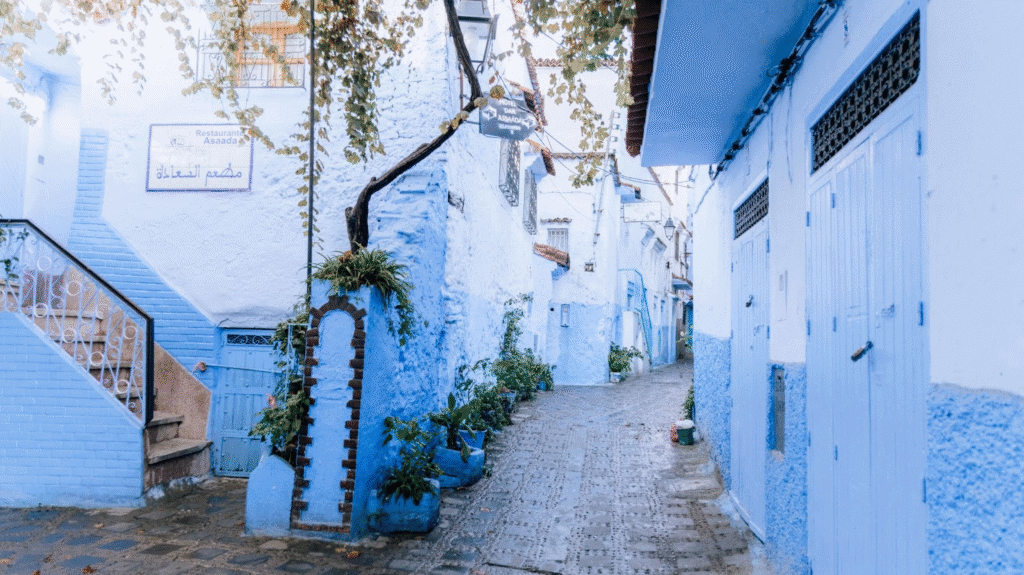
Meeting Locals
People in Chefchaouen are known for being friendly. Many speak some English or Spanish.
- Chat with shop owners (they love telling stories about the blue city)
- Visit the women’s weaving cooperative near the waterfall
- Join locals at Plaza Uta el-Hammam in the evening when families gather
Even a simple “Salam” (hello) goes a long way in making local friends.
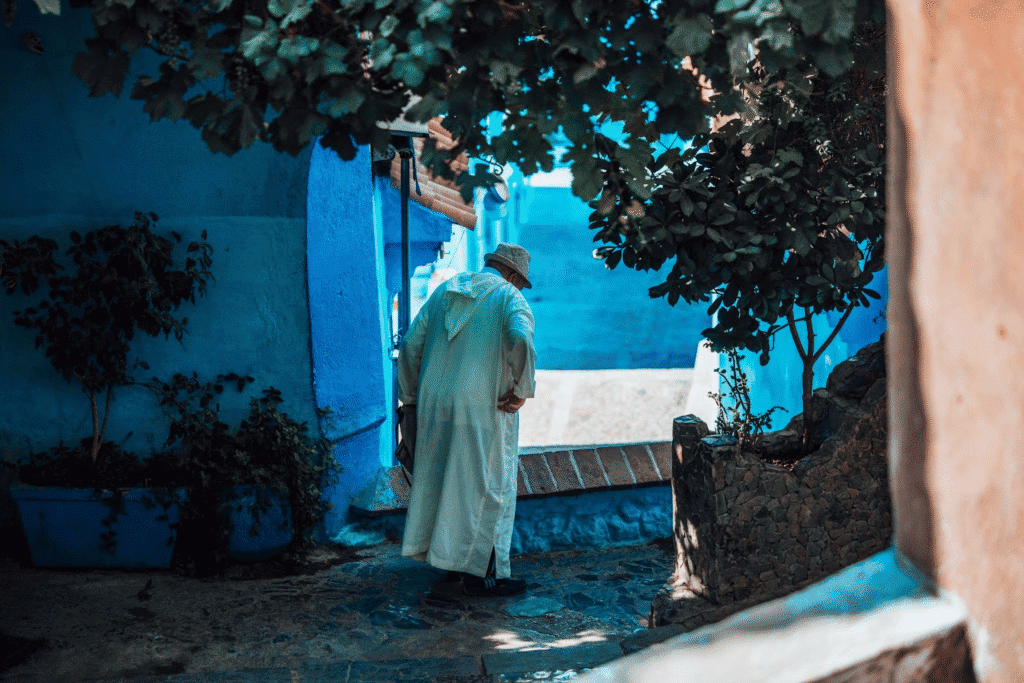
Where to Stay in Chefchaouen:
Riads in the Medina
Riads are old houses with inside gardens. They’re the best way to feel like you’re living in the blue city.
Top riads:
- Riad Cherifa (80-120 USD): Has a rooftop view and pretty rooms with traditional Moroccan decor. Their breakfast includes fresh orange juice and homemade breads.
- Dar Echchaouen (70-100 USD): Near the medina with a pool and garden. Rooms have air conditioning and WiFi. The staff speaks English and can arrange local guides.
- Casa Perleta (60-90 USD): Small but friendly with good breakfast. Only 8 rooms, each with unique blue decorations. Their terrace has one of the best views in town.
These places fill up fast, so book 2-3 months early if you can. Winter (except holidays) usually has more open rooms.
Boutique Hotels
For more comfort but still with local feel, try these:
- Lina Ryad & Spa (100-150 USD): Has a hammam bath and big rooms. Their spa offers traditional treatments with argan oil. The hotel restaurant serves both Moroccan and international food.
- Dar Baibou (70-100 USD): Beautiful but quiet spot with a peaceful courtyard. Each room has its own sitting area. Located at the edge of the medina for easy access.
- Hotel Madrid (60-80 USD): Spanish style with good food. Has been around since 1920 and keeps an old-world charm. The building itself is blue inside and out.
Budget Stays
Traveling on less money? No problem:
- Pension Souika (25-40 USD): Simple rooms but clean with shared bathrooms. The owner can tell you all about local history.
- Hotel Parador (30-50 USD): Basic but in a good spot near the kasbah. Has a simple breakfast included and 24-hour front desk.
- Hostel Aline (15-25 USD): Dorm beds with friendly staff who organize hiking trips. Has a shared kitchen if you want to cook your own meals.
Most budget places don’t take online bookings, so just show up early in the day. If you arrive after 2 PM, you might have fewer choices.

Luxury Options
For a special trip, these places offer more:
- Riad Hicham (150-200 USD): The fanciest place in town with a spa and rooftop restaurant. Rooms have fireplaces for winter stays and private balconies.
- Hotel Alkhalifa (120-170 USD): Outside the medina with big gardens and mountain views. Has a shuttle service to the medina every hour.
- Dar Jasmine (130-180 USD): Feels like a palace with amazing food. Each suite has hand-painted ceilings and antique furniture.
The best rooms face the mountains, so ask for these when booking. Most luxury places offer airport pickup from Tangier for around 800 MAD ($80).
In Chefchaouen, staying in the medina means climbing stairs, so if that’s hard for you, look for places near Plaza Uta el-Hammam or outside the walls. The streets can be slippery when wet, so bring good shoes.
Culinary Delights
Chefchaouen’s food mixes mountain ingredients with Moroccan cooking. The result is simple but tasty dishes you won’t find in other parts of the country.
Local Foods to Try:
- Tagine with local goat: Slow-cooked in clay pots with olives from nearby farms
- Bissara: Thick fava bean soup topped with olive oil and cumin
- Jben: Fresh goat cheese sold in the morning market (costs about 15 MAD)
- Mountain honey: Sold in small shops, darker and stronger than regular honey
Where to Eat:
Favorite Spots:
- Restaurant Aladdin: Great view of the plaza and good tagines (80-120 MAD)
- Café Clock: Try their camel burger! Also has a nice roof (70-100 MAD)
- Populi: Cheap local food, packed with locals (30-60 MAD)
- Beldi Bab Ssour: Best breakfast in town with fresh bread and eggs
For cheap eats, the food stalls near the main market serve grilled meats and fresh juice for under 30 MAD.
Cooking Classes
Learn to make Moroccan food at:
- Casa Aladdin: 3-hour class with market shopping (300 MAD)
- Lala Mesouda: Woman-run class in a local home (250 MAD)
You’ll learn to make tagine, couscous, and Moroccan salads.
Tea Culture
Mint tea is a big deal here. Locals drink it sweet with lots of mint. Tea shops are on every corner.
The best tea experience is at Arte Maroc Café. They show you how tea is made the mountain way. Costs 15 MAD but worth it!
Practical Travel Tips:
Money Matters
- The Moroccan dirham (MAD) is the currency (about 10 MAD = 1 USD)
- Bring cash! Only a few big places take cards
- ATMs are near the main square but can run out of money
- Most prices are lower than in bigger Moroccan cities
Speaking the Language
Most locals speak:
- Arabic
- Berber
- Spanish (more common than French here)
- Some English in tourist spots
Basic words that help:
- “Shukran” = Thank you
- “Salam” = Hello
- “La shukran” = No thank you (for pushy sellers)
Cultural Do’s and Don’ts
- Do dress modestly (cover shoulders and knees)
- Don’t eat with your left hand
- Do remove shoes when entering homes
- Don’t take photos of people without asking
Staying Safe
Chefchaouen is one of Morocco’s safest cities. Still:
- Keep valuables hidden
- Don’t walk alone in empty streets late at night
- Watch for slippery streets (the blue paint gets slick when wet)
- Drink bottled water
Taking Photos
- Early morning has the best light and fewer people
- Ask before taking photos of shops or people
- Some shop owners ask for small tips (5-10 MAD) for photos
- Avoid taking pictures inside mosques
Keep a portable charger handy – you’ll take more photos here than anywhere else!
Best Time to Visit Chefchaouen:
Spring and fall are the best times to visit Chefchaouen. Here’s why:
Spring (April to May) brings mild temperatures (65-75°F) and wildflowers on the mountain trails. The city feels fresh after winter rains, and the blue walls pop against green mountainsides.
Fall (September to October) offers warm days (70-80°F) and cool nights. Tourist crowds thin out after summer, and you’ll find better hotel deals.
Weather Patterns:
- Summer (June-August): Hot days (85-95°F) but cooler than other parts of Morocco
- Winter (November-March): Chilly (45-60°F) with some rainy days
- Snow: Rare in town but common on nearby mountains December-February
Festivals Worth Seeing:
- Cherry Festival (June): Local farmers celebrate the harvest with music and food
- Independence Day (November 18): Street parades and local music
- Eid celebrations: Dates change yearly, but bring exciting community events
The main tourist seasons are:
- High season: July-August (European vacations) and December (holidays)
- Low season: November and January-February (except holiday weeks)
If you hate crowds, avoid weekends year-round when Moroccan tourists visit from nearby cities.
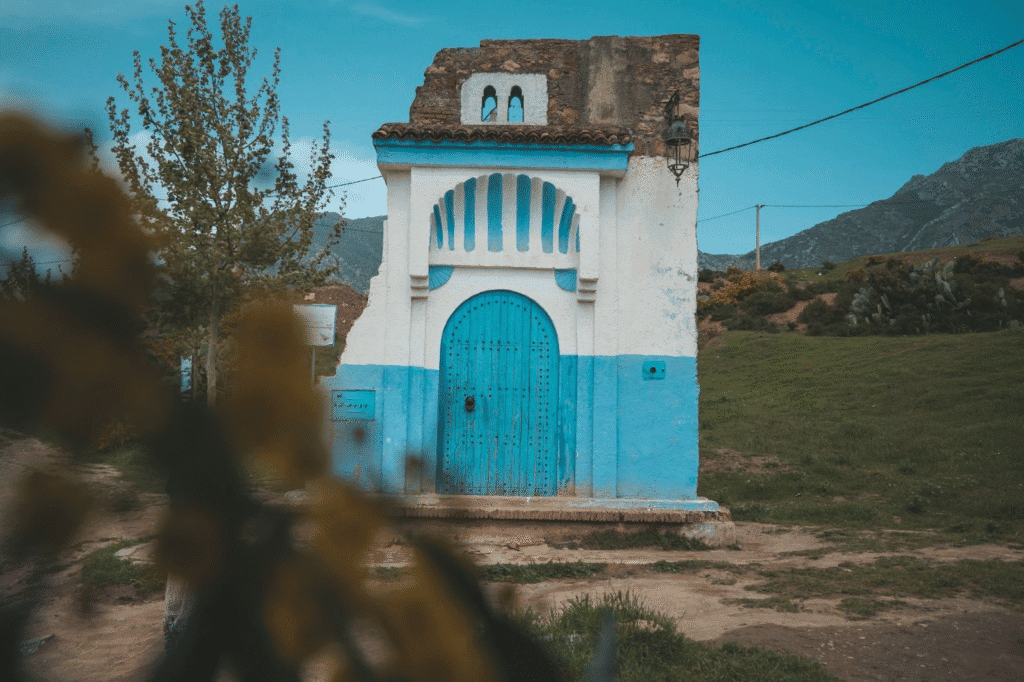
How to Include Chefchaouen in Your Morocco Itinerary
Chefchaouen fits perfectly into many Morocco trips. Here are some ways to include it:
Northern Morocco (5-7 days):
- Tangier (1 day)
- Chefchaouen (2-3 days)
- Fez (2-3 days)
This route works well if you’re coming from Spain by ferry to Tangier.
Classic Morocco (10-14 days):
- Casablanca (1 day)
- Rabat (1 day)
- Chefchaouen (2 days)
- Fez (2-3 days)
- Merzouga/Sahara (2-3 days)
- Marrakech (3-4 days)
Chefchaouen provides a relaxing break between busy cities in this popular route.
Morocco Private Tours offers several ways to visit Chefchaouen:
- Day trip from Tangier or Fez: Quick but rushed
- Blue City Explorer: 2-night package with guided tours and local food
- Northern Gems: 5-day tour combining Chefchaouen with Roman ruins at Volubilis and the historic city of Fez
Their drivers know the mountain roads well, and guides speak English, Spanish, and French. Prices start at 150 USD per day including transportation and guide.
The best choice is spending at least one night. This lets you see the town both in morning light and at sunset when most day-trippers have left.
Conclusion
Chefchaouen is a special break from busy Morocco. The blue streets, mountain views, and friendly locals make it different from big cities.
Unlike noisy markets in Marrakech, here you can walk, relax, and enjoy at your own speed. The blue maze feels magical, especially at sunrise or sunset.
Whether you stay for one day or three, the Blue Pearl will likely be a trip highlight. Your blue city photos will stand out from typical Morocco shots.
Ready to see Chefchaouen? Morocco Private Tours can add it to your trip. Their guides know hidden spots most tourists miss. Contact them today to add this blue gem to your Morocco adventure!
